Tribo-Surface Variation Caused by Ti2AlC and Ti3AlC2 Particles-Containing Lubricant under Cyclic Impact Loading
Abstract
:1. Introduction
2. Experimental Details
2.1. Experimental Materials
2.2. Friction and Wear Tests
3. Results and Discussion
3.1. Comparison of Friction and Wear Performance
3.2. Worn Surface Analysis
3.3. XPS Analysis on Tribofillms of Worn Cast Iron Surface
3.4. Lubrication Mechanism Analysis of Lubricants Containing Ti2AlC and Ti3AlC2 Particles
4. Conclusions
Author Contributions
Funding
Data Availability Statement
Conflicts of Interest
References
- Barsoum, M.W. The Mn+1AXn phases: A new class of solids; Thermodynamically stable nanolaminates. Prog. Solid State Chem. 2000, 28, 201–281. [Google Scholar] [CrossRef]
- Sun, Z. Progress in research and development on MAX phases: A family of layered ternary compounds. Int. Mater. Rev. 2011, 56, 143–166. [Google Scholar] [CrossRef]
- Li, X.; Xie, X.; Gonzalez-Juliana, J.; Malzbendera, J.; Yang, R. Mechanical and oxidation behavior of textured Ti2AlC and Ti3AlC2 MAX phase materials. J. Eur. Ceram. Soc. 2020, 40, 5258–5271. [Google Scholar] [CrossRef]
- Sun, G.Q.; Feng, M.; Zhang, K.; Wang, T.H.; Li, Y.H.; Han, D.H.; Li, Y.G.; Song, F. Q-Switched and Mode-Locked Er-doped fiber laser based on MAX phase Ti2AlC saturable absorber. Results Phys. 2021, 26, 104451. [Google Scholar] [CrossRef]
- Lu, S.; Li, X.; Zhou, Y.; Xu, W.; Pan, J. Synthesis and mechanical properties of TiB2/Ti2AlN composites fabricated by hot pressing sintering. J. Ceram. Soc. Jan. 2018, 126, 900–905. [Google Scholar] [CrossRef] [Green Version]
- Gonzalez-Julian, J. Processing of MAX phases: From synthesis to applications. J. Am. Ceram. Soc. 2021, 104, 659–690. [Google Scholar] [CrossRef]
- Tang, Z.; Li, S. A review of recent developments of friction modifiers for liquid lubricants (2007–present). Curr. Opin. Solid State Mater. Sci. 2014, 18, 119–139. [Google Scholar] [CrossRef]
- Gunda, R.K.; Narala, S.K.R. Tribological studies to analyze the effect of solid lubricant particle size on friction and wear be-haviour of Ti-6Al-4V alloy. Surf. Coat. Technol. 2016, 308, 203–212. [Google Scholar] [CrossRef]
- Wu, Y.; Tsui, W.C.; Liu, T. Experimental analysis of tribological properties of lubricating oils with nanoparticle additives. Wear 2007, 262, 819–825. [Google Scholar] [CrossRef]
- Chinas-Castillo, F.; Spikes, H.A. Mechanism of action of colloidal solid dispersions. J. Tribol. 2003, 125, 552–557. [Google Scholar] [CrossRef]
- Lee, K.; Hwang, Y.; Cheong, S.; Choi, Y.; Kwon, L.; Lee, J.; Kim, S.H. Understanding the Role of Nanoparticles in Nano-Oil Lubrication. Tribol. Lett. 2009, 35, 127–131. [Google Scholar] [CrossRef]
- Hu, Z.; Lai, R.; Lou, F.; Wang, L.; Chen, Z.; Chen, G.; Dong, J. Preparation and tribological properties of nanometer magnesium borate as lubricating oil additive. Wear 2002, 252, 370–374. [Google Scholar] [CrossRef]
- Zhou, X.; Shi, H.; Zhang, S.; Fu, X.; Wang, X. Friction and Wear Properties of Cyanex 302-Modified MoS2 Micro-Sized Spheres as Additive in Liquid Paraffin. Tribol. Trans. 2008, 51, 454–459. [Google Scholar] [CrossRef]
- Liu, G.; Li, X.; Qin, B.; Xing, D.; Guo, Y.; Fan, R. Investigation of the mending effect and mechanism of copper nano-particles on a tribologically stressed surface. Tribol. Lett. 2004, 17, 961–966. [Google Scholar] [CrossRef]
- Wang, N.; Wang, H.; Ren, J.; Gao, G.; Zhao, G.; Yang, Y.; Wang, J. High-efficient and environmental-friendly PTFE@SiO2 core-shell additive with excellent AW/EP properties in PAO6. Tribol. Int. 2021, 158, 106930. [Google Scholar] [CrossRef]
- Gosvami, N.N.; Bares, J.A.; Mangolini, F.; Konicek, A.R.; Yablon, D.G.; Carpick, R.W. Mechanisms of antiwear tribofilm growth revealed in situ by single-asperity sliding contacts. Science 2015, 348, 102–106. [Google Scholar] [CrossRef] [Green Version]
- Tysoe, W. On Stress-Induced Tribochemical Reaction Rates. Tribol. Lett. 2017, 65, 48. [Google Scholar] [CrossRef]
- Nehme, G.; Dib, M. Fluorinated mix in plain ZDDP oil and commercial oil using design of experiment analysis of all interactions and fundamental study of fluorinated mix in plain ZDDP oils under 2 different r/min test cycles and extreme boundary lubrication. Proc. Inst. Mech. Eng. Part J J. Eng. Tribol. 2011, 225, 193–211. [Google Scholar] [CrossRef]
- Varlot, K.; Martín, J.; Grossiord, C.; Vargiolu, R.; Vacher, B.; Inoue, K. A dual-analysis approach in tribochemistry: Application to ZDDP/calcium borate additive interactions. Tribol. Lett. 1999, 6, 181–189. [Google Scholar] [CrossRef]
- Aldana, P.U.; Vacher, B.; Le Mogne, T.; Belin, M.; Thiebaut, B.; Dassenoy, F. Action Mechanism of WS2 Nanoparticles with ZDDP Additive in Boundary Lubrication Regime. Tribol. Lett. 2014, 56, 249–258. [Google Scholar] [CrossRef]
- Sharma, V.; Timmons, R.B.; Erdemir, A.; Aswath, P.B. Interaction of plasma functionalized TiO2 nanoparticles and ZDDP on friction and wear under boundary lubrication. Appl. Surf. Sci. 2019, 489, 372–383. [Google Scholar] [CrossRef]
- Berkani, S.; Dassenoy, F.; Minfray, C.; Belin, M.; Vache, B.; Martin, J.M.; Cardon, H.; Montagna, G.; Reynard, B. Model for-mation of ZDDP tribofilm from a mixture of zinc metaphosphate and goethite. Tribol. Int. 2014, 79, 197–203. [Google Scholar] [CrossRef]
- Vyavhare, K.; Timmons, R.B.; Erdemir, A.; Edwards, B.L.; Aswath, P.B. Tribochemistry of fluorinated ZnO nanoparticles and ZDDP lubricated interface and implications for enhanced anti-wear performance at boundary lubricated contacts. Wear 2021, 474–475, 203717. [Google Scholar] [CrossRef]
- Vyavhare, K.; Timmons, R.B.; Erdemir, A.; Edwards, B.L.; Aswath, P.B. Robust interfacial tribofilms by borate- and poly-mercoated ZnO nanoparticles leading to improved wear protection under a boundary lubrication regime. Langmuir 2021, 37, 1743–1759. [Google Scholar] [CrossRef] [PubMed]
- Tu, Z.; Hu, E.; Wang, B.; David, K.D.; Seeger, P.; Moneke, M.; Stengler, R.; Hu, K.; Hu, X. Tribological behaviors of Ni-modified citric acid carbon quantum dot particles as a green additive in polyethylene glycol. Friction 2020, 8, 182–197. [Google Scholar] [CrossRef] [Green Version]
- Meng, Y.; Su, F.; Chen, Y. Supercritical Fluid Synthesis and Tribological Applications of Silver Nanoparticle-decorated Graphene in Engine Oil Nanofluid. Sci. Rep. 2016, 6, 31246. [Google Scholar] [CrossRef] [Green Version]
- Zhang, R.; Ding, Q.; Zhang, S.; Niu, Q.; Ye, J.; Hu, L. Construction of a continuously layered structure of h-BN nanosheets in the liquid phase via sonication-induced gelation to achieve low friction and wear. Nanoscale 2019, 11, 12553–12562. [Google Scholar] [CrossRef]
- Huynh, K.K.; Tieu, K.A.; Pham, S.T. Synergistic and Competitive Effects between Zinc Dialkyldithiophosphates and Modern Generation of Additives in Engine Oil. Lubricants 2021, 9, 35. [Google Scholar] [CrossRef]
- Ali, M.K.A.; Hou, X. Colloidal stability mechanism of copper nanomaterials modified by bis(2-ethylhexyl) phosphate dispersed in polyalphaolefin oil as green nanolubricants. J. Colloid Interface Sci. 2020, 578, 24–36. [Google Scholar] [CrossRef]
- Li, W.; Yu, B.; Ye, B.; Shen, Y.; Huang, R.; Du, F. Effects of Cast-Iron Surface Texturing on the Anti-Scuffing Performance under Starved Lubrication. Materials 2019, 12, 1586. [Google Scholar] [CrossRef] [Green Version]
- Wang, W.; Li, C.; Yang, J.; Shen, Y.; Xu, J. Friction performance of MoDTP and ester-containing lubricants between CKS piston ring and cast iron cylinder liner. Lubr. Sci. 2018, 30, 33–43. [Google Scholar] [CrossRef]
- Morina, A.; Neville, A.; Priest, M.; Green, J.H. ZDDP and MoDTC interactions and their effect on tribological performance—Tribofilm characteristics and its evolution. Tribol. Lett. 2006, 24, 243–256. [Google Scholar] [CrossRef]
- Table of Elements. Available online: https://www.thermofisher.cn/cn/zh/home/materials-science/learning-center/periodic-table.html (accessed on 25 January 2022).
- Nslund, L.K.; Persson, P.; Rosen, J. X-ray photoelectron spectroscopy of Ti3AlC2, Ti3C2Tz, and TiC provides evidence for the electrostatic interaction between laminated layers in MAX-Phase materials. J. Phys. Chem. C. 2020, 124, 27732–27742. [Google Scholar] [CrossRef]
- Costa, H.L.; Evangelista, K.S.; Cousseau, T.; Acero, J.S.R.; Kessler, F. Use of XANES and XPS to investigate the effects of ethanol contamination on anti-wear ZDDP tribofilms. Tribol. Int. 2021, 159, 106997. [Google Scholar] [CrossRef]
- Massoud, T.; De Matos, R.P.; Le Mogne, T.; Belin, M.; Cobian, M.; Thiébaut, B.; Loehlé, S.; Dahlem, F.; Minfray, C. Effect of ZDDP on lubrication mechanisms of linear fatty amines under boundary lubrication conditions. Tribol. Int. 2020, 141, 105954. [Google Scholar] [CrossRef]
- Minfray, C.; Martin, J.M.; Esnouf, C.; Mogne, T.L.; Kersting, R.; Hagenhoff, B. A multi-technique approach of tribofilm char-acterisation. Thin Solid Film. 2004, 447, 272–277. [Google Scholar] [CrossRef]
- Nedelcu, I.; Piras, E.; Rossi, A.; Pasaribu, H.R. XPS analysis on the influence of water on the evolution of zinc dialkyldithi ophosphate–derived reaction layer in lubricated rolling contacts. Surf. Interface Anal. 2012, 44, 1219–1224. [Google Scholar] [CrossRef]
- Huai, W.; Chen, X.; Lu, F.; Zhang, C.; Ma, L.; Wen, S. Tribological properties of sulfur- and phosphorus-free organic molybdenum compound as additive in oil. Tribol. Int. 2020, 141, 105944. [Google Scholar] [CrossRef]
- Crobu, M.; Rossi, A.; Mangolini, F.; Spencer, N.D. Tribochemistry of Bulk Zinc Metaphosphate Glasses. Tribol. Lett. 2010, 39, 121–134. [Google Scholar] [CrossRef]
- Iatsunskyi, I.; Gottardi, G.; Micheli, V.; Canteri, R.; Coy, E.; Bechelanyc, M. Atomic layer deposition of palladium coated TiO2/Si nanopillars: ToF-SIMS, AES and XPS characterization study. Appl. Surf. Sci. 2021, 542, 148603. [Google Scholar] [CrossRef]
- Wilhelmsson, O.; Palmquist, J.-P.; Lewin, E.; Emmerlich, J.; Eklund, P.; Persson, P.; Högberg, H.; Li, S.; Ahuja, R.; Eriksson, O.; et al. Deposition and characterization of ternary thin films within the Ti–Al–C system by DC magnetron sputtering. J. Cryst. Growth 2006, 291, 290–300. [Google Scholar] [CrossRef]
- Mahmoudi, Z.; Tabaian, S.H.; Rezaie, H.R.; Mahboubi, F.; Ghazali, M.J. Synthesis of Ti2AlC & Ti3AlC2 MAX phases by Arc-PVD using Ti–Al target in C2H2/Ar gas mixture and subsequent annealing. Ceram. Int. 2020, 46, 4968–4975. [Google Scholar]
- Edachery, V.; Shashank, R.; Kailas, S.V. Influence of surface texture directionality and roughness on wettability, sliding angle, contact angle hysteresis, and lubricant entrapment capability. Tribol. Int. 2021, 158, 106932. [Google Scholar] [CrossRef]
- Wan, S.; Tieu, A.K.; Xia, Y.; Wang, L.; Li, D.; Zhang, G.; Zhu, H.; Tran, B.H.; Mitchell, D. Tribochemistry of adaptive integrated interfaces at boundary lubricated contacts. Sci. Rep. 2017, 7, 9935. [Google Scholar] [CrossRef] [PubMed] [Green Version]
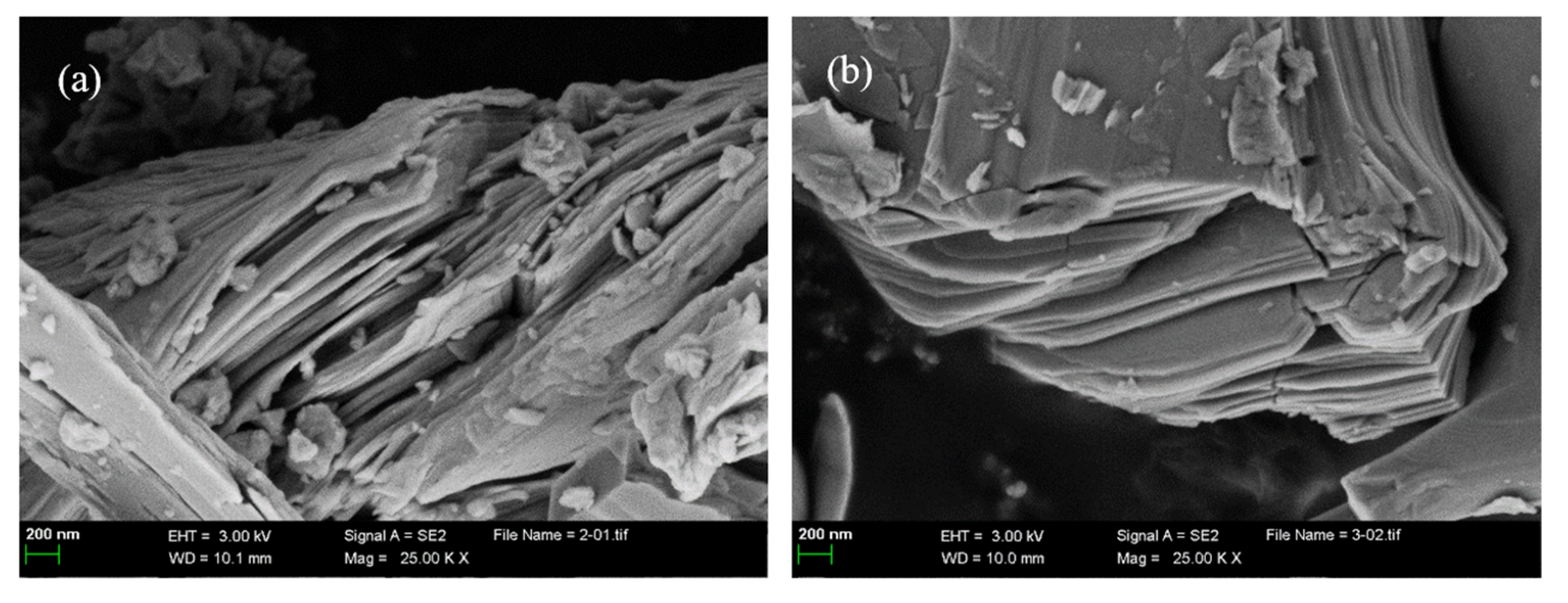
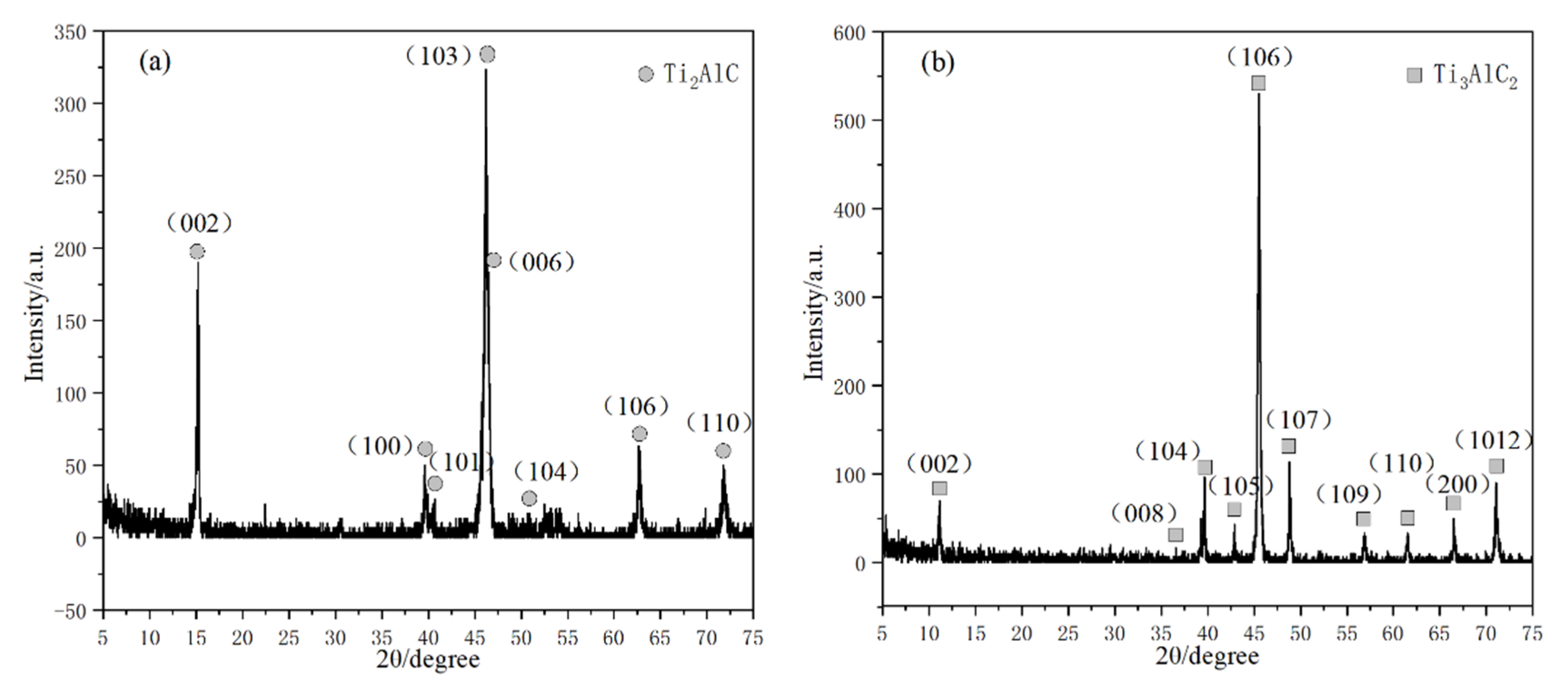
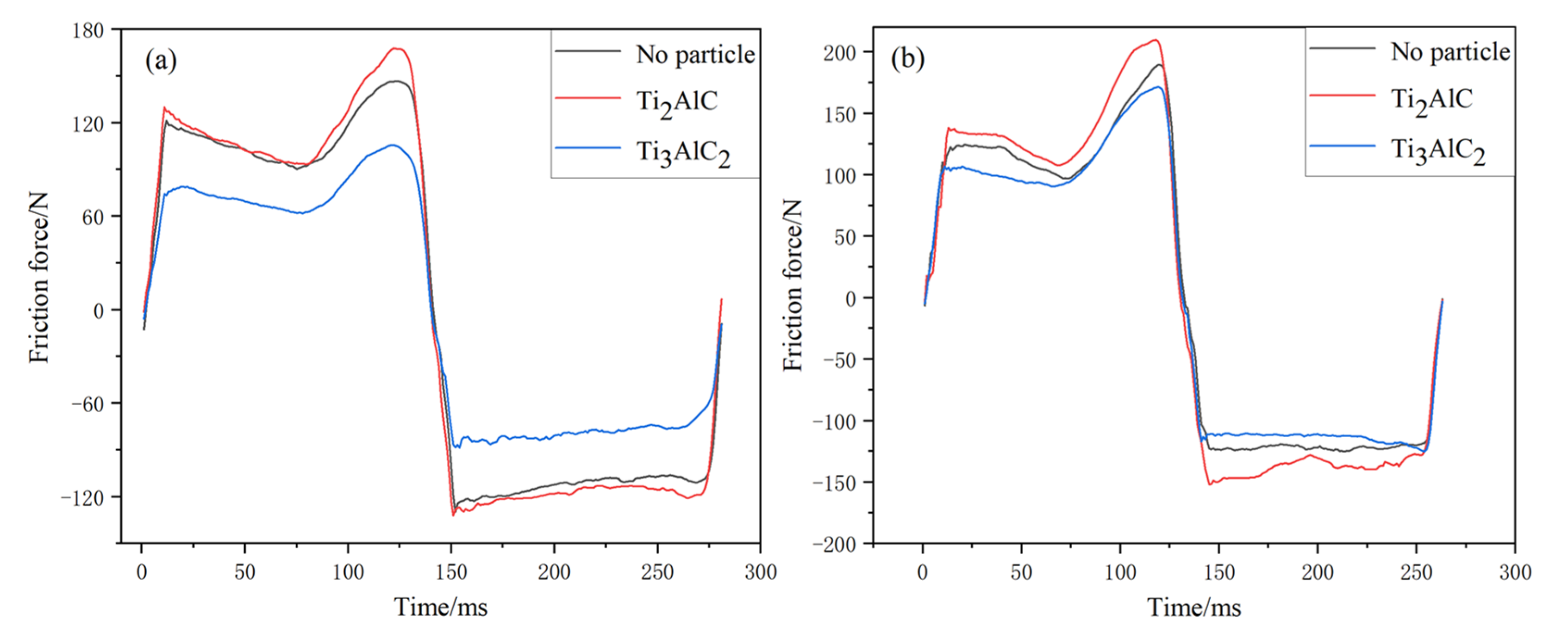
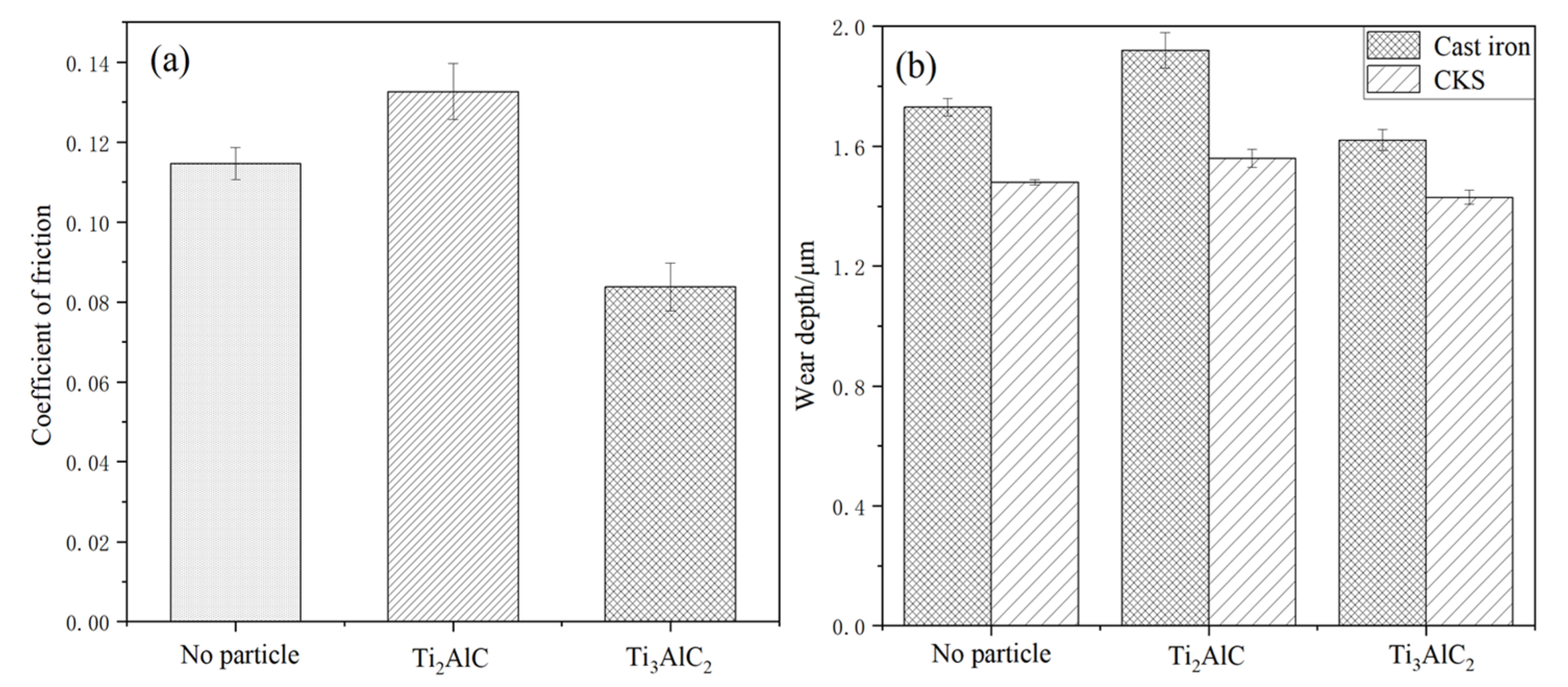
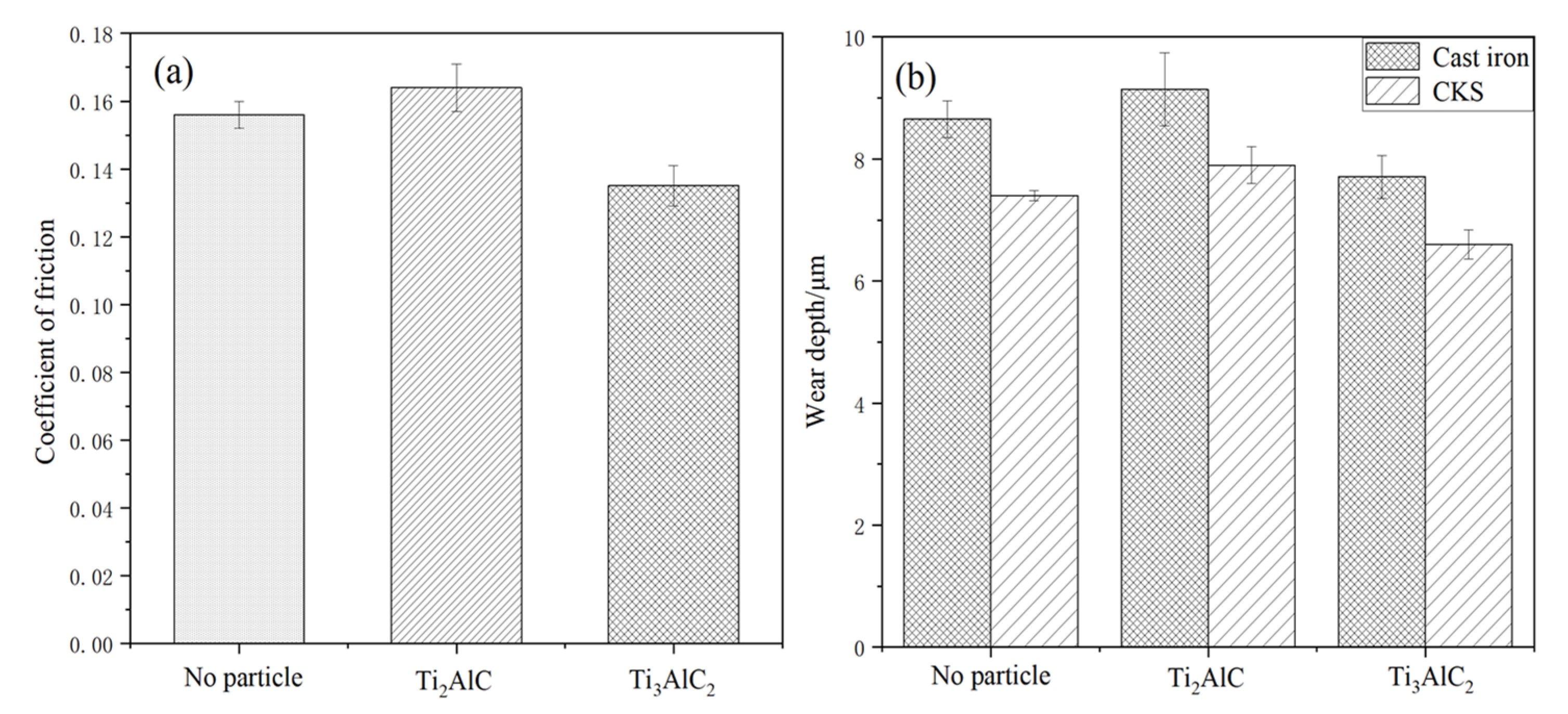

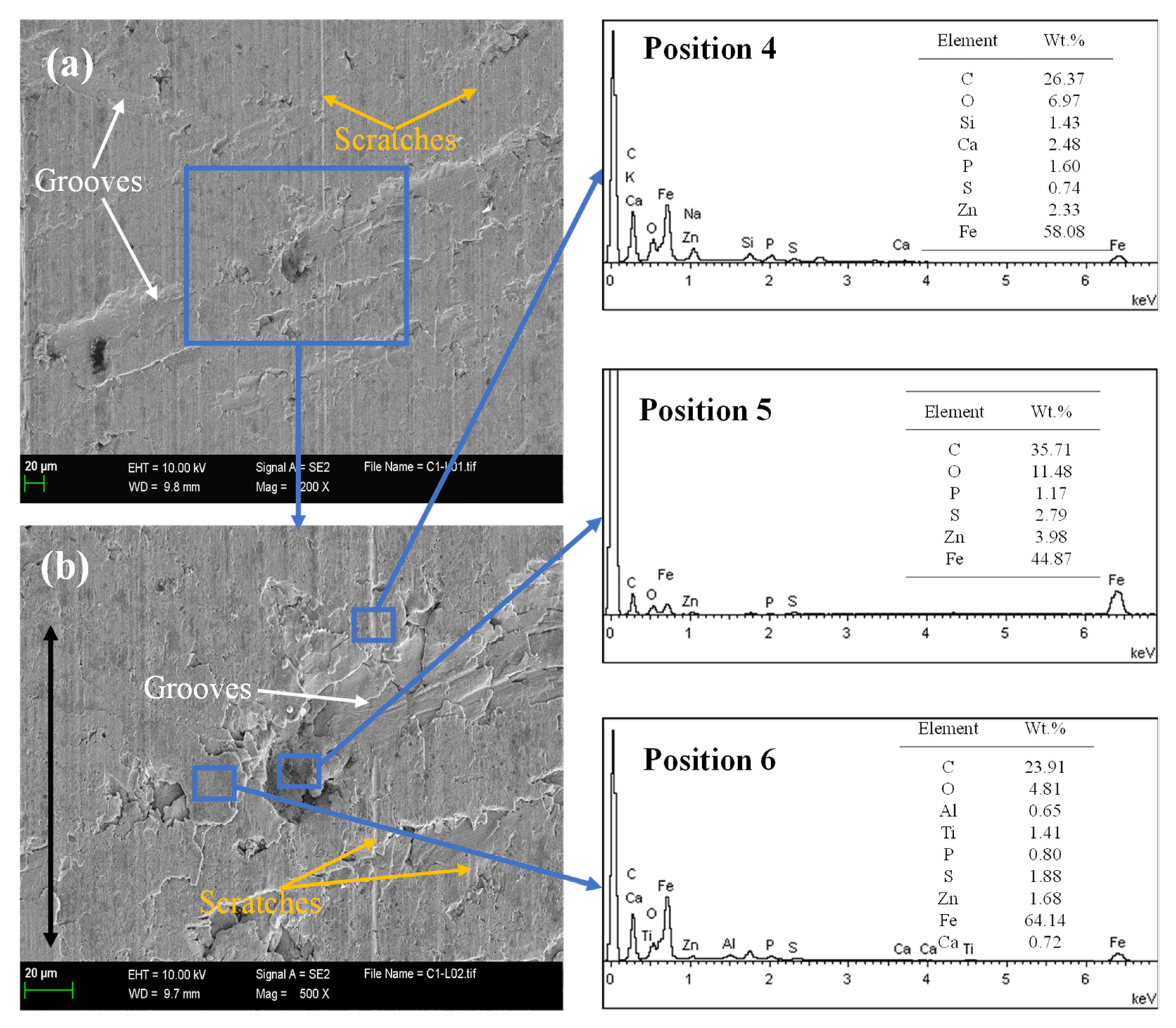

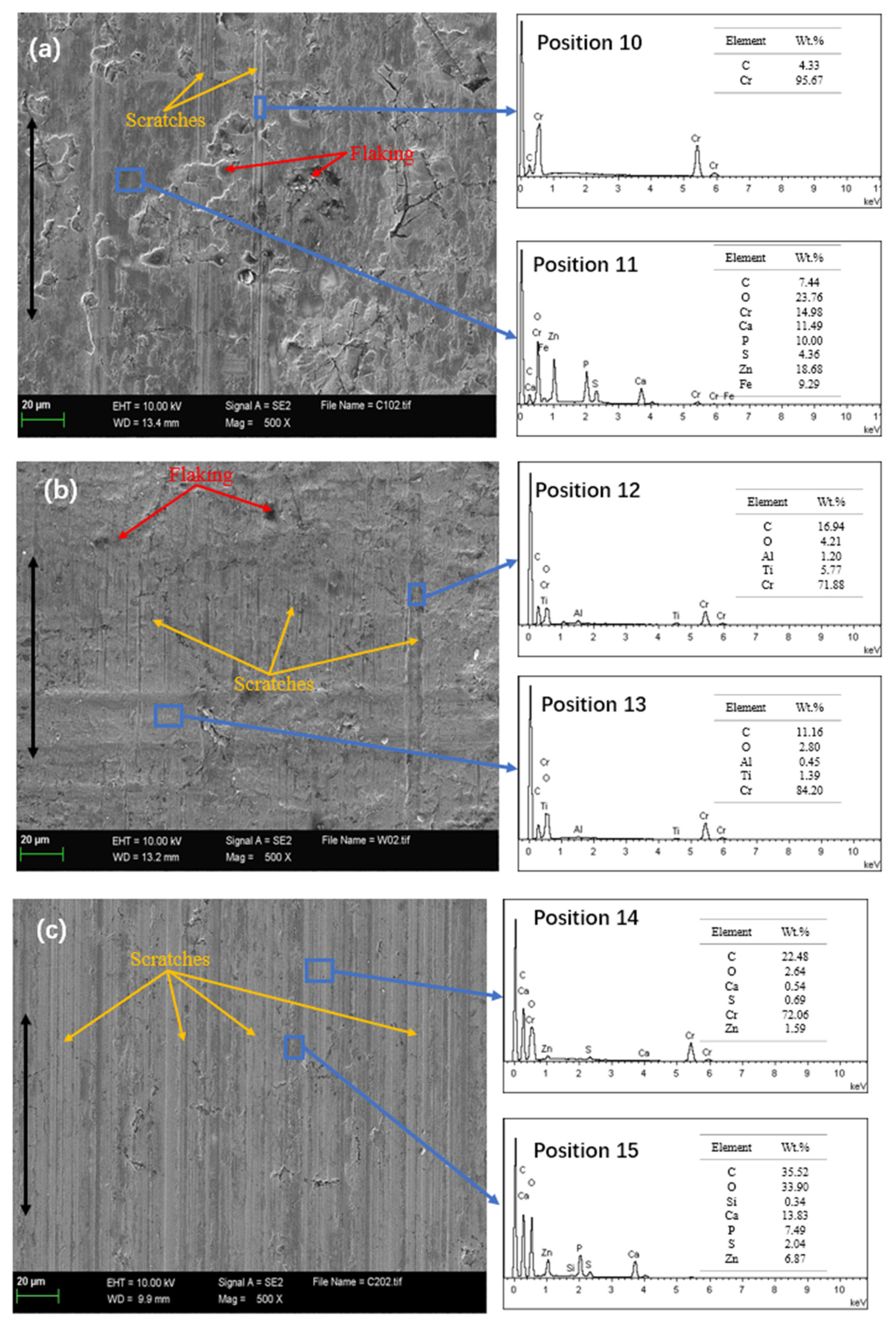
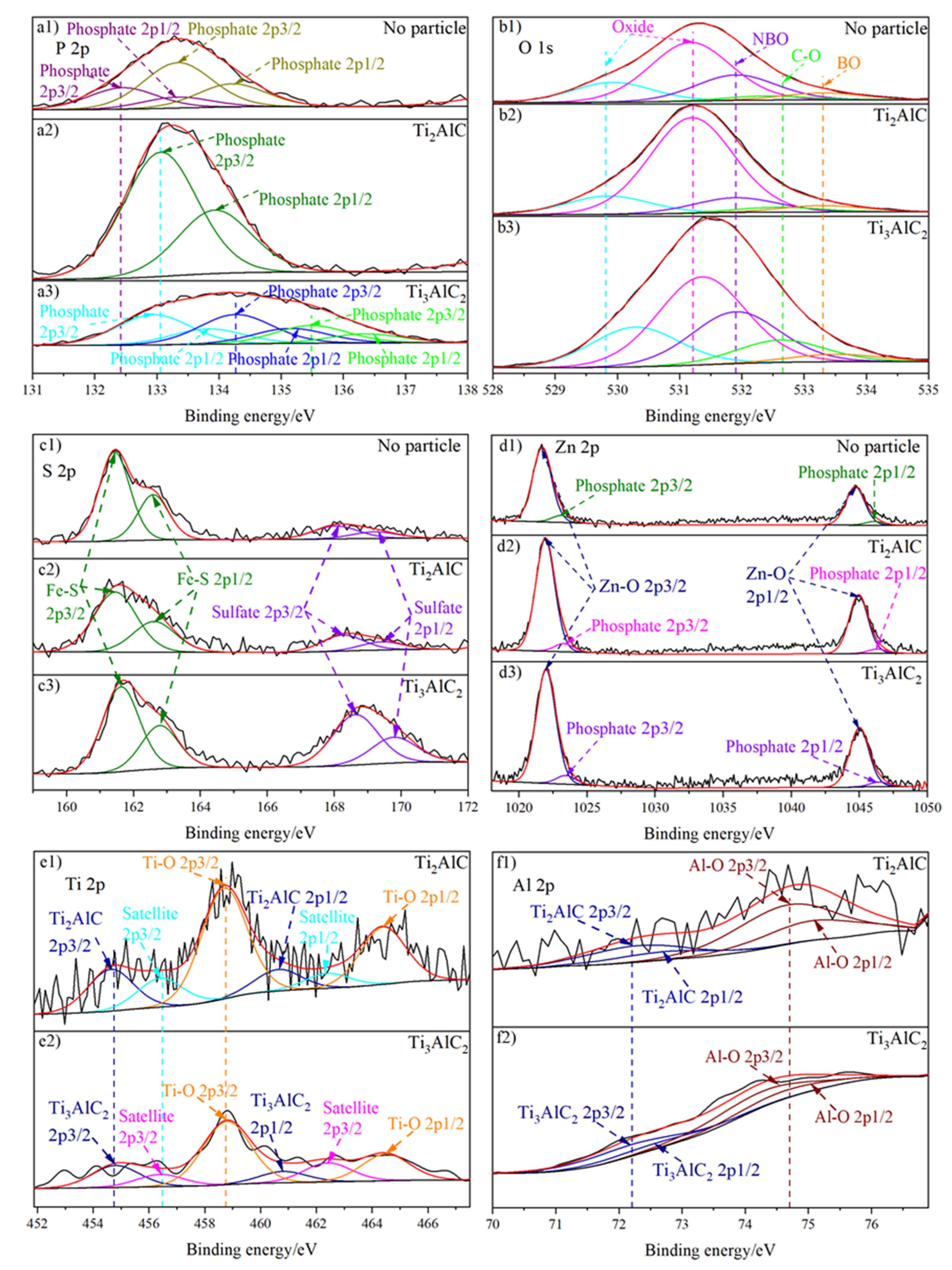
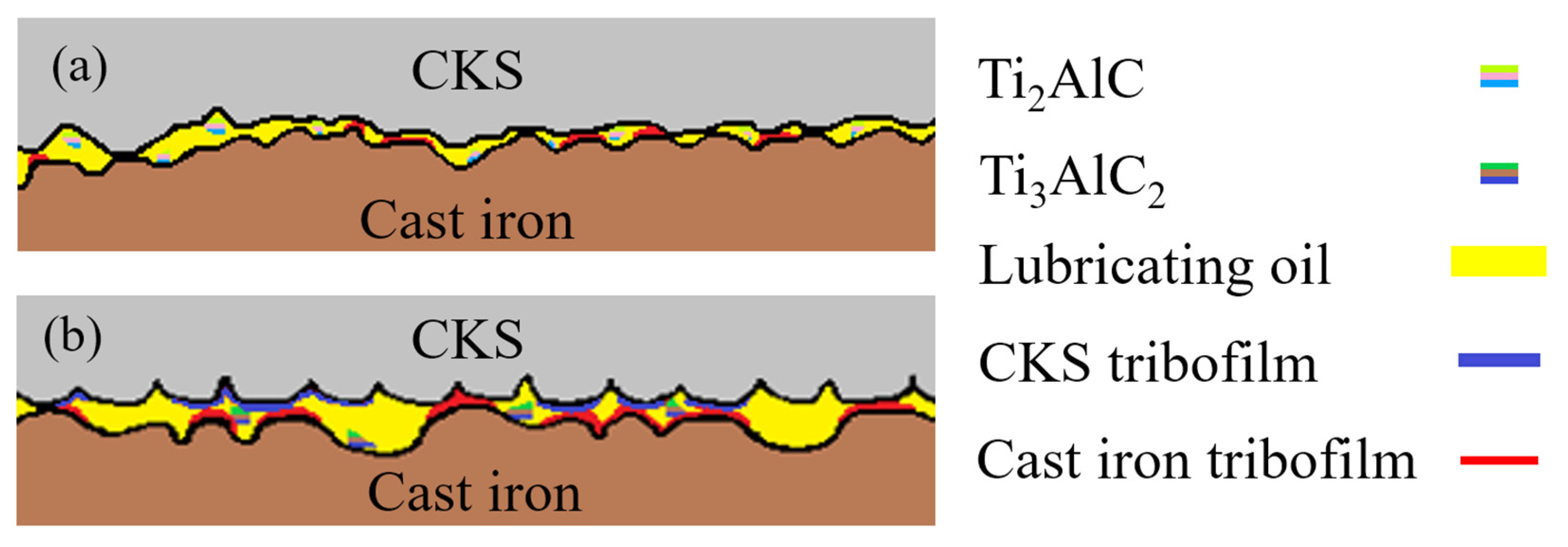
| Experimental Stage | Experimental Parameters | ||||
|---|---|---|---|---|---|
| Speed (r/min) | Max. Impact Load (MPa) | Temperature (°C) | Oil Supply Rate (mL/min) | Time (min) | |
| Running in | 200 | 10 | 200 | 0.1 | 10 |
| Steady state | 200 | 50 | 200 | 0.1 | 180 |
Publisher’s Note: MDPI stays neutral with regard to jurisdictional claims in published maps and institutional affiliations. |
© 2022 by the authors. Licensee MDPI, Basel, Switzerland. This article is an open access article distributed under the terms and conditions of the Creative Commons Attribution (CC BY) license (https://creativecommons.org/licenses/by/4.0/).
Share and Cite
Shen, Y.; Liu, Z.; Xing, C.; Li, Q.; Fan, J. Tribo-Surface Variation Caused by Ti2AlC and Ti3AlC2 Particles-Containing Lubricant under Cyclic Impact Loading. Lubricants 2022, 10, 33. https://doi.org/10.3390/lubricants10030033
Shen Y, Liu Z, Xing C, Li Q, Fan J. Tribo-Surface Variation Caused by Ti2AlC and Ti3AlC2 Particles-Containing Lubricant under Cyclic Impact Loading. Lubricants. 2022; 10(3):33. https://doi.org/10.3390/lubricants10030033
Chicago/Turabian StyleShen, Yan, Zhixiang Liu, Chuanfei Xing, Qi Li, and Junjing Fan. 2022. "Tribo-Surface Variation Caused by Ti2AlC and Ti3AlC2 Particles-Containing Lubricant under Cyclic Impact Loading" Lubricants 10, no. 3: 33. https://doi.org/10.3390/lubricants10030033






